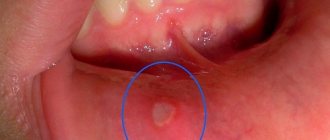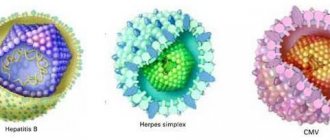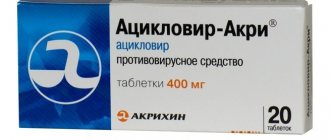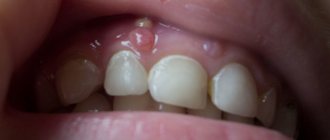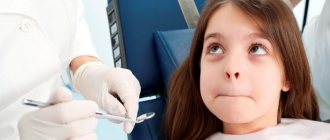- Herpes in the mouth
- Herpes in the throat
- Tongue herpes
- Herpes on the eyes
- Herpes on the chin
- Cold on the nose
- Cold on the lips
- Treatment of herpes on the lips
- How to treat herpes on the lips
Herpes appears as tiny, painful blisters
rashes on different parts of the body, most often on the face.
Herpes on the face is localized near the lips, wings of the nose, on the forehead, cheeks and, most unpleasantly, on the mucous membrane of the nose and eyes. The disease is caused by herpes simplex virus type 1. 8 types of virus
in total , but the rest manifest themselves differently.
Herpes on the face - symptoms
Everyone knows what herpes looks like on the face. The appearance of bubbles can be predicted by the characteristic tingling sensation on the lips
.
At this stage, you can prevent rashes using folk remedies or antiviral drugs. If time is lost, then bubbles appear along the upper edge of the lips , which quickly increase in size and quantity. The diameter of the bubbles can be from 1 to 5 millimeters
.
Their appearance is accompanied by severe itching .
They are filled with cloudy liquid and are very unpleasant to touch. However, if you simply puncture small blisters on the face and burn the area with an alcohol-containing product, this will not solve the herpes problem. Note In addition to external manifestations, herpes causes inconvenience with fever and general malaise. Lymph nodes located near the rash may also become enlarged and inflamed.
In total, herpes on the face goes through 4 stages:
- tingling, itching, tingling in the place where the bubble will soon appear;
- inflammation – a fluid-filled blister appears on the skin or mucous membrane;
- ulceration - the bubble bursts, fluid flows out, and an ulcer forms;
- appearance of a crust.
On average, all four stages together should not last more than 10 days
.
The third stage
is considered the most dangerous , when a liquid containing many viral cells flows out of the vesicle and infects the wound a second time. Also at this time, other bacteria or viruses may enter the wound, which will only worsen the situation.
Many people know what a cold on the face looks like. But besides the well-known localization on the lips, herpes can “craw out”:
- on any part of the face - on the cheeks, nose, forehead, chin;
- on the nasal mucosa;
- in the eyes - this is conjunctivitis caused by the herpes virus;
- in the mouth;
- in the ears.
Many people do not consider pimples on the face to be a manifestation of herpes. For example, someone has no idea about herpes on the ear.
Manifestations of herpes on the face may be the result of the development of herpes zoster
, or
herpes zoster
.
Herpes zoster on the face differs from simple herpes in that the blisters are larger and more painful. Its consequence is neuralgia on the face - unpleasant sensations in the places where the rashes were localized , namely: pain, numbness, tingling, increased sensitivity, itching, headache
.
A herpetic lesion can be very large - the entire face can be covered with blisters. In addition to painful sensations, herpes on the face is dangerous because the blisters may not go away without a trace, but will leave behind small scars.
What will we treat?
There are 6 types of herpes virus. The skin and mucous membranes are most often affected by two types - herpes simplex virus (HSV 1 or 2) and herpes zoster virus (Varicella-Zoster). The symptoms of these diseases are almost the same, but before treating herpes on the face, you need to know the type of virus. Treatment tactics for different diseases vary somewhat.
Herpes simplex virus
The most common pathogen that causes herpes infection. It affects the skin and mucous membranes. Herpes on the face is usually caused by HSV type 1. HSV is quite stable in the external environment; it dies under the influence of ultraviolet irradiation and high temperature.
Penetration of viral particles occurs through the skin and mucous membranes. The virus multiplies in epithelial cells, causing their death. Then HSV reaches the nerve ganglia along the nerve fibers, where it enters a latent state. When favorable conditions for the pathogen arise, the infection is reactivated.
The main symptom of herpes infection on the face is a specific vesicular rash. It is represented by small grouped bubbles, inside of which there is a clear liquid. The blisters burst, forming painful and itchy erosions. Skin lesions of herpes are usually localized on the face - lips, chin, nasolabial triangle, wings of the nose. The forehead and area around the eyes are less commonly affected. The appearance of a rash on these parts of the face is considered a prognostically unfavorable sign.
Shingles
This form of herpes is caused by the Varicella-Zoster virus, the causative agent of chickenpox. If a person has previously had chickenpox, the pathogen is stored in the nerve ganglia. In the presence of predisposing factors, the infection reactivates in the form of herpes zoster. This name is associated with the peculiarity of the rashes - they appear along the nerve fibers, as if encircling an area of the body.
More details about shingles on the face - dangerous complications are possible!
On the face, shingles is most often localized in the area of the trigeminal or facial nerve fibers - the chin, cheeks, forehead. Sometimes the appearance of rashes is observed on the scalp. People of any age get sick. The disease is characterized by initial symptoms in the form of pain along the nerve fibers. The pain can reach significant intensity.
2-3 days after the onset of pain, specific rashes appear on the face. First, small pink spots form on the skin, then in their place bubbles with transparent contents appear, as with herpes simplex. They are arranged linearly or in the form of an oval. The bubbles do not burst, but dry out, leaving a crust. After a few days, the crust disappears, leaving no scars.
A feature of the course of herpes zoster is postherpetic neuralgia. These are pain sensations that occur after recovery. The pain can persist for several months and is burning or aching in nature.
Why does herpes appear on the face?
The cause of facial rashes is the herpes virus. This virus affects a significant part of the world's population, although many do not develop blisters at all. Herpes is transmitted through skin contact or the exchange of body fluids. Many people inherit
from parents already at birth. The virus is very easily transmitted; under normal conditions, it can survive on any surface for up to a day.
The herpes virus can live in the body for many years without detecting itself externally. But under certain conditions it begins to appear in the form of bubbles, including on the face.
What causes herpetic rashes:
- colds - ARVI, flu, etc.;
- hypothermia;
- exacerbation of chronic diseases;
- seasonal lack of vitamins;
- stress;
- prolonged fatigue, overexertion.
That is, any decrease in the body’s immune defense is an impetus for active reproduction and external manifestation of herpes. Also, herpes on the cheeks or other areas of the face can appear with severe weight loss, alcohol and tobacco abuse
.
Herpes on the body (shingles)
It is caused by a type 3 virus - the same as chickenpox in children. Chickenpox is the primary reaction to the penetration of the virus. After the acute stage of herpes, the disease develops into chronic herpes, with the virus hiding in nerve cells for several decades, after which, for as yet unknown reasons, herpes becomes more active and causes shingles in some people. Signs of herpes zoster are rashes on the chest, on one side, along the rib, and in rare cases on the neck. They are accompanied by severe pain, which in some cases remains for a long time (herpetic neuralgia). Less commonly, the virus affects the optic nerves, and then signs of herpes rashes appear in the eye area. This is one of the most serious forms of the disease. Other types of herpes viruses can cause lymphoma (type 4), infectious mononucleosis (type 5), roseola infantile (type 6), Kaposi's sarcoma (type 8). Chronic fatigue syndrome is associated with herpes virus type 7.
Herpes on the face in children
Herpes on the face of a child can be localized anywhere. Many people associate the appearance of herpetic blisters with poor hygiene. In children, the virus is transmitted through household contact, and very quickly. If in adults, in order to become infected with herpes, the virus needs to get on the mucous membranes, then in children, the virus enters the body even through the skin. In children, herpes on the face is usually localized near the wings of the nose or near the eyes. Very often, herpetic blisters appear in the mouth - this is stomatitis.
Attention: Children are difficult to tolerate herpes. If this disease is not treated, it can be accompanied by such serious illnesses as meningitis and pneumonia.
The danger of childhood herpes on the face is that the child cannot tolerate the itching and scratches wounds that become infected ( especially if you scratch them with dirty hands
), spreads herpes even further across the face.
Genital herpes during pregnancy
Genital herpes during pregnancy If the primary infection with genital herpes occurs during pregnancy, then the risk of harmful effects on the fetus is quite high. In many cases, a miscarriage or developmental defects may occur in the child, since the mother’s body does not yet have anti-herpes antibodies, the virus penetrates the placenta to the fetus and damages it. If the infection occurred earlier, before pregnancy, then the antibodies produced by the mother’s body prevent the herpes virus from actively multiplying, protecting the fetus. In this case, only childbirth in the presence of herpetic eruptions on the genitals poses a danger.
Treatment of herpes on the face
Herpes is an incurable disease. When people ask how to quickly cure herpes on the face, they mean getting rid of visible manifestations. The herpes virus will remain in the body forever, but its activity can be reduced .
To treat herpetic manifestations, medications are used, and to alleviate the patient’s condition, folk remedies are used.
Before treating herpes on the face, it is necessary to understand that the approach should be comprehensive and include:
- taking antiviral drugs;
- the use of ointments and creams that have a wound healing effect;
- strengthening the immune system.
Causes
Herpes zoster on the face is caused by external and internal factors.
Herpes zoster on the face is caused by external and internal factors. It most often manifests itself against the background of a decrease in general and local immunity.
Herpes manifests itself against the background of a decrease in general and local immunity, which occurs under the influence of various stress factors:
- hypothermia or overheating;
- excessive insolation (exposure to solar radiation);
- acute respiratory and viral infections;
- severe systemic and autoimmune diseases;
- chronic stress;
- hypovitaminosis;
- malnutrition;
- chronic dermatoses;
- contact with a patient with exacerbation of HSV;
- taking immunosuppressants and antibiotics;
- chemotherapy and radiotherapy;
- dermatological manipulations and operations.
Herpes zoster occurs in every fifth patient over 50 years of age if he had chickenpox in childhood. Reduced immunity in childhood and old age causes the frequent occurrence of herpes zoster in these age groups.
In some cases, the development of the virus develops against the background of severe hypothermia.
Is herpes on the face contagious?
The herpes virus is transmitted through direct contact with rashes on the patient's skin. Moreover, HSV-3 is dangerous for those who have not had chickenpox. The patient is contagious during the period when herpetic blisters appear on the skin. The virus can be transmitted with their contents by getting on hygiene items - washcloth, brush, towel. For women, cosmetics are a dangerous carrier of the virus. It is believed that during the period of remission, herpes on the face is harmless.
Antiviral agents for the treatment of herpes on the face
Note Antiviral drugs against herpes are used in different forms. These can be creams, tablets, and injections.
The following drugs have proven effectiveness:
- acyclovir;
- valacyclovir;
- famciclovir.
All effective medications against herpes are based on these drugs, although they are produced under different names: Zovirax, Valtrex, Herpeval, etc.
The choice of medicine for herpes depends on the number of rashes and accompanying symptoms. If these are single bubbles on the lip, then you can get by with a cream that is applied up to six times a day
.
Effective ointments for herpes on the face: Acyclovir, Zovirax, Vivorax, Fenistil Pencivir, Viru-Merz Serol. Ointment for colds on the face is used for up to 5 days
. If there is no effect, then you need to consult a doctor.
If there are a lot of rashes, and the temperature has risen, then you should immediately consult a doctor to select antiviral medications in the form of tablets. At the same time, you also need to use cream. In case of very severe spread of herpes, acyclovr is prescribed intravenously
.
If herpetic rashes rarely bother you ( once or twice a year)
), you can limit yourself to self-treatment. If more often, complex therapy is necessary, since simply “silencing” herpes will lead to the virus becoming stronger and manifesting itself with greater force each time.
Medicines for the treatment of herpes on the face have a negative effect on the liver and can cause allergies, but you cannot do without them. Herpes medications are contraindicated for pregnant women, nursing mothers, and children. The question of prescribing drugs in these cases should be decided by the doctor. Of the drugs that do not pose a danger to children and pregnant women, it is worth noting oxolinic ointment and bonafton in the form of tablets and ointments. Bonaftone ointment is effective and safe for the treatment of ocular herpes.
Note Attention: any antiviral drugs for herpes should be taken for no more than 14 days!
Norm of herpetic rashes on the lip per year
The norm for rashes to appear on the lips is no more than 2 times a year. During this period, the immune system is restored. Clinical manifestations may disappear on their own.
When frequent outbreaks of herpes on the lips occur, it becomes dangerous to health. The occurrence of inflammation more than 2 times a year is considered a deviation from the norm. Sometimes the disease occurs every month. However, herpes can persist for a long time, which leads to a serious weakening of the body’s protective function.
Herpetic rashes weaken the immune system. During illness, which occurs frequently, a person is susceptible to other viral and bacterial infections.
The appearance of frequent rashes on the lips up to 6 times a year requires seeking medical help. The doctor will diagnose the functioning of internal organs. In most cases, the following diseases become common problems, which are distinguished according to the frequency of occurrence in men and women. More details in the table.
| Men | Women | Men and women |
| Possible hypothyroidism syndrome | ||
| 46% | 46% | 46% |
| Pathology of the thyroid gland | ||
| 47% | 46% | 47% |
| Without disruption of the thyroid gland | ||
| 47% | 46% | 46% |
Immunostimulating drugs
Immunostimulating drugs are used to prevent and treat herpes. As a rule, they all have antiviral activity. Among them it is worth noting:
- lykopid is an immunostimulant that can be given even to children; taken once a day for 10 days;
- derinat – increases general immunity, has no contraindications;
- cycloferon - injections of the drug are given in two courses according to the scheme prescribed by the doctor, with a break of two weeks, can be used to treat herpes in children over 4 years of age and adults;
- Viferon - used at the first signs of herpes on the face (tingling or pinching), the course of treatment is up to 7 days, there are no contraindications or restrictions on the use of this drug.
Folk remedies , such as echinacea in increasing immunity
– the tincture can be bought at a pharmacy and taken daily, stirring 2 tablespoons of tincture in a glass of water, the course of treatment is 10-14 days.
Symptoms
The incubation period during the initial episode of the disease is accompanied by general malaise. Some patients experience low-grade body temperature and external signs of a cold: lacrimation, inflammation of the nasal mucosa, swelling of the face.
Symptomatic signs of herpes on the face are as follows:
- At the initial stage, a papule is formed (a nodule that rises above the surface of the skin). A tingling sensation is felt at the site of future rashes. When palpating the affected area of skin, pain occurs, the intensity of which depends on the location of the herpetic rash and the severity of the inflammatory process. Herpes on the eyebrow is accompanied by numbness in the affected area.
- A herpetic rash occurs, accompanied by severe itching.
- The bubbles burst. A scab forms and falls off over time.
- The virus goes deep into the nerve ganglia of the spinal cord. The risk of reactivation increases in conditions of weakened immunity.
Herpes on the face is characterized by severe itching, redness and swelling. Rashes appear a few days after the onset of the disease.
What does herpes look like on the face?
The clinical picture of herpes in the facial area is as follows:
- The inflammatory process begins with the formation of papules, which then transform into itchy vesicles with transparent contents.
- When the blisters burst, ulcers form in their place. Healing of erosions is accompanied by the formation of a crust.
Herpes in the eye area manifests itself as follows:
- Conjunctivitis. The epithelium covering the eyeball and the inside of the eyelids is damaged. Additionally, redness of the eye mucosa is observed.
- Blepharoconjunctivitis. Simultaneously with inflammation of the conjunctiva, a herpetic rash occurs along the eyelash line, which is accompanied by stinging and pain.
- Keratitis. Characteristic rashes form on the cornea.
- Keratoiridocyclitis is a severe form of viral infection. Blood vessels are affected, and an inflammatory process develops in the cornea.
Herpes in the eye area manifests itself as follows: simultaneously with inflammation of the conjunctiva, a herpetic rash appears along the eyelash line, which is accompanied by stinging and pain.
How to treat herpes on the eye?
The symptoms of herpes on the nasal mucosa differ from the clinical picture of the disease in the area of the nasolabial triangle in the following manifestations:
- The blisters are covered with a thick layer of cells, which resembles an abscess.
- Developed wounds heal in a shorter time. A crust will not form.
A blister that appears in the chin area resembles a subcutaneous pimple in appearance. But a distinctive feature is the severe itching that accompanies the growth of vesicles.
Folk remedies for herpes on the face
Traditional medicine is suitable for alleviating the patient's condition. They dry wounds, promote their speedy healing, and also relieve pain and itching.
.
Effective folk remedies for the treatment of herpes on the face:
- tincture of calendula in alcohol or oil - used for lotions or rubbing; The property of calendula to suppress viral infections, including herpes, is used;
- decoction or infusion of chamomile, string, celandine - for rubbing and compresses;
- infusion of tansy flowers - has an antiviral effect, it is taken orally and applied to blisters on the face;
- aloe and Kalanchoe - juice is squeezed out of these domestic plants and the wounds are lubricated with it; you can apply a fresh cut of the plant to the wound; You can also take a teaspoon of juice orally for 2 weeks to increase immunity;
- garlic - you can simply apply a cut clove of garlic to the bubbles or mix chopped garlic with honey and lubricate the affected area with this ointment several times a day.
Note To cauterize wounds, you can use Corvalol and any alcohol-containing products. Zinc ointment, bepanthen, and rosehip oil are suitable for drying and speedy healing of ulcers.
If folk remedies do not help, then you should use ointments for herpes on the face containing acyclovir, or even consult a doctor to select antiviral and immunomodulatory tablets. Not a single folk remedy for herpes on the face will help if the rash appears over a large area, is accompanied by fever, does not go away within two weeks and spreads further.
.
Also, folk remedies are powerless against recurrent herpes, that is, appearing three times a year
or more often.
Causes of frequent colds on the lips
So, we figured out that frequent herpes on the lips is a relapse of herpes three times a year. Now let's look at why herpes often starts to appear on the lips and the reasons for this phenomenon. Before we move on to the factors, it should be noted that herpes that often appears on the lips or other areas of the skin always indicates a weakened immune system. This is a feature of the virus itself, especially during re-infection. Therefore, with a weakened immune system, almost any factor that suppresses it subsequently leads to a relapse of herpes on the lips.
The following factors can cause frequent colds on the lips:
- poor or low-quality nutrition;
- hypothermia and frequent colds;
- for sore throat and ARVI;
- overheating in the sun or general overheating of the body;
- the occurrence of frequent cold rashes may be due to smoking;
- frequent consumption of drinks containing caffeine;
- with frequent depression and stress;
- with frequent alcohol consumption;
- often herpes on the lips does not go away with diabetes or AIDS;
- for diseases associated with the stomach or intestines.
As you can see, there are many factors that cause the recurrence of herpes in the lip area. Even an unstable emotional state can provoke frequent colds. Therefore, it is necessary to monitor not only the physical component of your body, but also try to control yourself on an emotional level.
Prevention of herpes on the face
Herpes on the face can have different causes. This is either a virus already present in the body
, or primary infection.
To avoid contracting herpes, you must observe personal hygiene .
This is especially true for children. If someone in the house suffers from herpes, it is necessary to provide the person with individual dishes, it is advisable for him to wear a mask at home, not kiss children and other family members - that is, be careful. What causes herpes on the face? It affects people with weakened immune systems. This means that this must be prevented, namely:
- don't catch a cold;
- do not overwork;
- lead a healthy lifestyle;
- take vitamin supplements seasonally.
If you follow these recommendations, you won’t have to look for an answer to the question of how to deal with herpes on the face.
Mutating herpes
Herpes, like any virus, is tenacious and capable of mutation. If earlier experts stated that the herpes virus of the first type, which causes ulcers on the lips, is transmitted only through direct contact and cannot be infected by airborne droplets, now they say that this method of transmission is also possible. There is information that herpes infection can occur at a distance of up to one and a half meters or more, especially when coughing and sneezing.
If earlier two types of herpes were clearly distinguished - type 1, labial, which appears on the lips, and type 2, genital, affecting the mucous membrane of the genital organs, now they are talking about the “migration” of these two brothers. Prevention measures: be careful during oral-genital contacts, maintain personal hygiene, do not use other people’s towels, shared utensils, etc.
With a weakened immune system, herpetic rashes can affect not only the mucous membranes of the eyes, nose, lips, and intimate areas, but also spread throughout the body, sometimes covering large areas of the skin. Strengthening the immune system so that the body does not give the opportunity to be active will allow you to see herpes on your lips less often.
